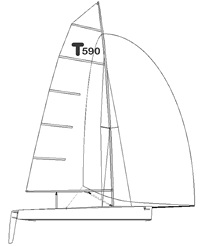T590
One design
My Mum was a Kiwi and so is this new dinghy, called the T590 and designed by the notable New Zealand naval architect Steve Thompson. Steve designs a lot of very fast boats and created this one with his own needs in mind. The aim was to separate the thrills from the fear of sailing a fast boat.
Now here is where we get on thin ice. Is it a dinghy when it has a ballast keel? The T590 has a nifty, whalelike bulb at the bottom of its lifting fin. This bulb weighs 290 pounds and is pinned to the fin so it can be easily removed for shipping. Technically speaking, I think the fact that this boat is ballasted takes it out of the dinghy category. But for all intents and purposes this is a dinghy. The 19-foot LOA and 780-pound all-up weight also make this one push hard against the dinghy categorization. The benefit of the ballasted keel is that the T590 is self-righting. It's also unsinkable, with two buoyancy tanks in the bow.
This is an unusual boat starting with the hull form. Rather than orient this boat toward planing performance, Steve designed a hull that would be happy going to weather. This means the stern is a little narrower than you would find on most planing dinghies, while the topsides flare amidships to little wings to aid hiking. This gives the boat a pumpkin-seed-shaped hull form with the wings hiding a deceptively narrow BWL and a very fine bow for piercing a chop. I had a boat like this once, a Wylie Wabbit, and it was an incredibly wet boat to sail at high speeds. It was like someone had a fire hose on you. The wings on the T590 prevent the bow wave from spraying up into the crew's face.
There is quite a marked arc to the sections at the stern as opposed to flatter planing-type sections. The keel is retractable for shipping and is left down once the boat is in the water. There isn't a lot of form stability to this design.
The unusual hull form is capped by an unusual rig, for there is no jib on this boat. In fact, it's a bit like the X3. There's a big main, without the extended fat-head-type upper roach, and an asymmetrical chute or gennaker that flies from a retractable bowsprit, which is about 5 feet long. The gennaker is launched from a tunnel in the bow with an endless halyard so it can be easily raised and doused. The same line that raises the chute hauls it back down into the tunnel. According to the designer it was a cost issue to go with the single-spreader mast. An all-carbon mast could have avoided the spreaders, but it was too expensive. The sa/d is 38.7 with main alone and over 100 when you add the gennaker. I did not include crew weight as this boat is ballasted. The T590 is built in E-glass and epoxy.
I have no trouble envisioning the 590 sitting on my buoy. This boat would be easy to singlehand in our light Pacific Northwest winds. My aesthetic inclinations would lean toward a Herreshoff 121/2, but my performance expectations would draw me to the T590. I think I would rather scoot along looking ordinary than sit glued to one spot looking good. Come to think about it, just going fast is a pretty sight in itself. I'll take the T590
Unconventional speed machine from New Zealand.

Comments